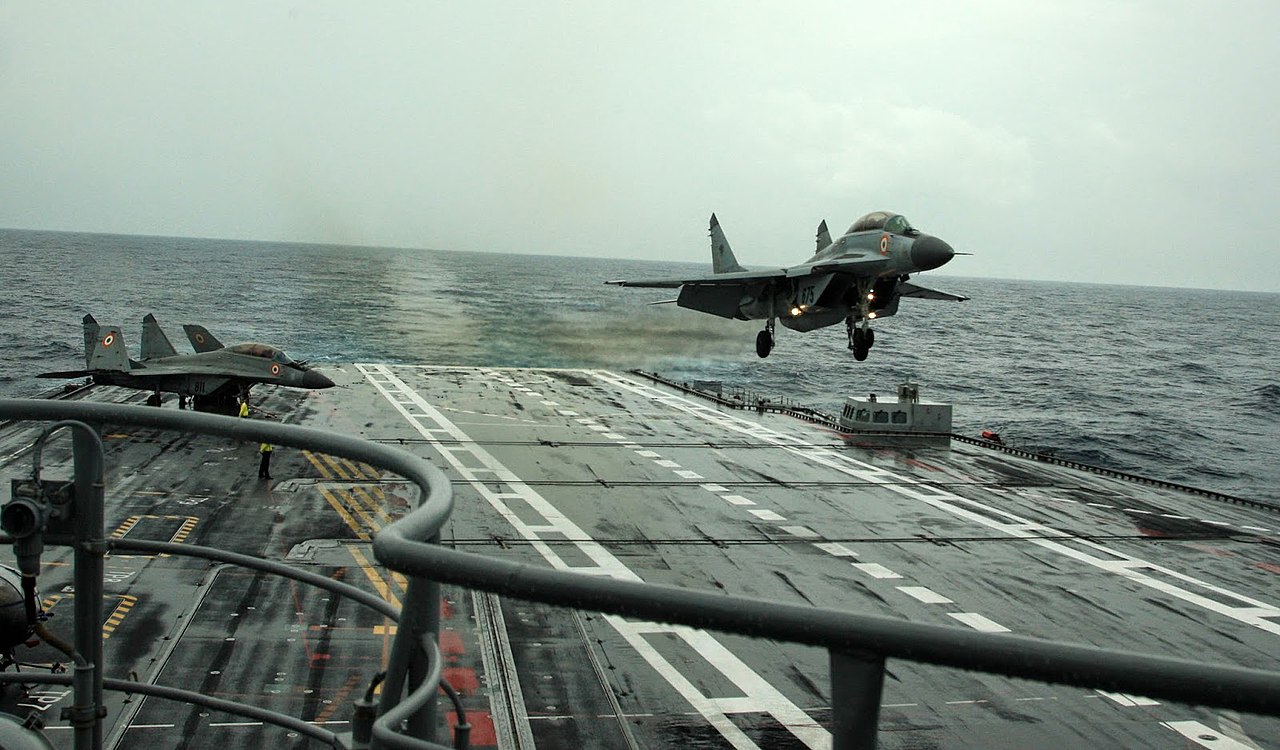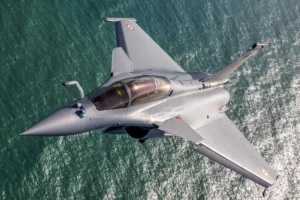India’s Ministry of Defense has missed an excellent opportunity to arm its navy with the third aircraft carrier it so justifiably deserves. The Defense Acquisition Council, headed by Minister of Defense Rajnath Singh, failed to accord approval for only the first step in the entire procurement process in its meeting on November 30.
All that the Indian Navy had sought from the DAC was to kickstart the process of acquiring the third aircraft carrier in its fleet through an Acceptance of Necessity, which is to agree with the naval assessment that there is a need for a third aircraft carrier.
If the DAC had approved this proposal, said to be worth just about Rs 40,000 crore (about US$5 billion), the defense ministry would have kickstarted the realization of the Indian Navy’s long-cherished dream of operating three aircraft carriers.
The operational justification for three aircraft carriers is that at least two functional aircraft carriers would be deployed on the eastern and western seaboard, while the third is under a refit, which is an inevitable outcome.
The Indian Navy proposed constructing the second indigenous aircraft carrier (IAC-2) at the Cochin Shipyard Limited at Kochi in Kerala state in southern India only as a “repeat order” for the already commissioned INS Vikrant, which CSL built in 15 years.

The Indian Navy had indeed dreamt of having a nuclear-powered aircraft carrier in its fleet when the IAC-2 plans were drawn in 2016. However, the Indian government told the navy to moderate its demand given the funds’ crunch and budgetary constraints.
A nuclear-powered aircraft carrier would have meant a full year’s capital budget would have to go to the Navy in phases over ten years. But the nifty fingers at the defense finance would not allow that to happen, lest other services start demanding such substantial budgetary allocations.
Thus, the Indian Navy settled for only the second iteration of IAC through a domestic manufacturer and agreed to a repeat of the smaller electric-propulsion variant of INS Vikrant.
Tentatively, the new Indigenous Aircraft Carrier is christened as Vishal. It is now expected that the Acceptance of the Necessity of the second Indigenous Aircraft Carrier will happen in the next two or three Defence Acquisition Council meetings, ahead of the nation heading to a general election season from February to May 2024.
This also means there would be a delay in the project itself. Vishal shall enter the Indian Navy service only by 2035, according to a conservative estimate. But the navy is okay with this delay, as it wants an aircraft carrier that packs the punch to dominate India’s area of maritime interest that has been expanding from the Indian Ocean Region between the Strait of Hormuz on the western front and the Strait of Malacca on the eastern front, to extend into the South China Sea.
The Indian government must take a quick call on the second Indigenous Aircraft Carrier project. The reason is the dying skills of the Cochin Shipyard workers in building aircraft carriers that they have learned so painstakingly over the last 12 to 15 years while building INS Vikrant.
The Indian Navy aims to address its operational needs, given that INS Vikrant will be combat-ready only by mid-2024 and INS Vikramaditya has been in service with the Indian Navy for ten years, commissioned in November 2013.
With three aircraft carriers, the Indian Navy would keep pace with all the navies deployed in the Indo-Pacific region. The maritime landscape is evolving rapidly, with geopolitical dynamics and regional security concerns demanding robust naval capabilities.
In this context, the case for the Indian Navy acquiring a third aircraft carrier becomes not only pertinent but imperative. It is not just about countering China in the IOR but safeguarding India’s interests and continuing to assert its pre-eminence in the region.
Strategic Imperatives
Extended Maritime Reach: A third aircraft carrier would significantly enhance India’s maritime reach, allowing the Navy to project power across vast expanses of the Indian Ocean Region (IOR). This extended reach is crucial for safeguarding vital sea lines of communication, securing trade routes, and responding effectively to emerging threats in a region of growing geopolitical importance.

Deterrence Capability: A robust naval presence is a deterrent, dissuading potential adversaries from aggressive actions. A third aircraft carrier would reinforce India’s deterrence posture, signaling the ability and willingness to respond decisively to any threat. The mere presence of such a formidable asset would contribute to regional stability by discouraging destabilizing activities.
Power Projection: A third carrier would provide the Indian Navy with enhanced power projection capabilities, enabling it to conduct sustained and concurrent operations in different strategic theaters. This flexibility is vital for responding to diverse security challenges, from conventional naval threats to maritime terrorism, thus offering a comprehensive approach to safeguarding national interests.
Operational Advantages
Reducing Operational Gaps: Naval operations often involve complex and dynamic scenarios that require a constant and formidable presence. A third carrier would help bridge operational gaps during maintenance cycles or deployments, ensuring a continuous and reliable naval presence. This redundancy is crucial for maintaining maritime dominance in the IOR.
Enhanced Force Structure: With an additional carrier, the Indian Navy could sustain a more formidable force structure, facilitating the deployment of carrier battle groups for extended durations without straining resources. This would allow for a more effective response to evolving threats, whether traditional naval challenges or emerging asymmetric threats.
Amphibious and Humanitarian Operations: A third carrier would enhance combat capabilities and provide critical support for amphibious and humanitarian operations. Carriers are mobile airbases, facilitating rapid response and power projection during natural disasters or evacuation operations.

Geopolitical Considerations
Symbol of Naval Dominance: A third aircraft carrier would symbolize India’s commitment to maintaining regional naval dominance. This symbolism is vital in shaping regional perceptions, fostering strategic partnerships, and consolidating India’s position as a net security provider in the IOR.
Enhancing Strategic Partnerships: Naval power is a critical element of diplomatic outreach, and possessing a third carrier would enhance India’s ability to engage in joint exercises and collaborations with strategic partners. This would strengthen maritime security cooperation, contributing to regional stability and counterbalancing the influence of other naval powers in the region.
Economic Implications: Investing in a third carrier would boost the defense sector and have positive financial repercussions. Such a carrier’s construction, maintenance, and operation would generate employment opportunities, foster technological advancements, and stimulate economic growth, aligning with the broader goals of national development.
Conclusion
The acquisition of a third aircraft carrier is not merely an option for the Indian Navy; it is a strategic imperative dictated by the evolving maritime landscape, security challenges, and geopolitical considerations.
Such a carrier would bolster India’s naval capabilities and contribute significantly to regional stability, economic growth, and diplomatic influence.
As the Indian Navy strives to assert itself as a formidable force in the IOR, a third aircraft carrier stands as a symbol of commitment to maritime security and a powerful tool for safeguarding national interests in an increasingly complex world.
- NC Bipindra is a 30-year veteran in journalism specializing in strategic affairs, geopolitics, aerospace, defense, and diplomacy. He has written extensively for the Times of India, New Indian Express, Press Trust of India, and Bloomberg News. He can be reached at ncbipindra (at) gmail.com
- Follow EurAsian Times on Google News






